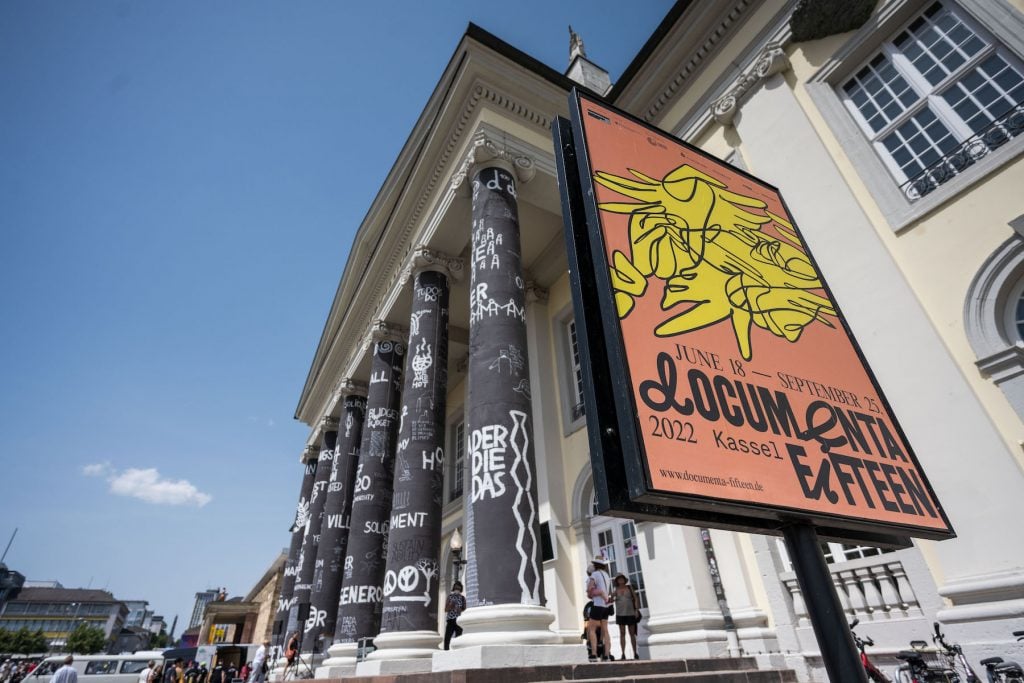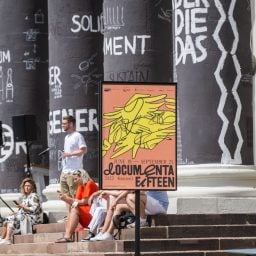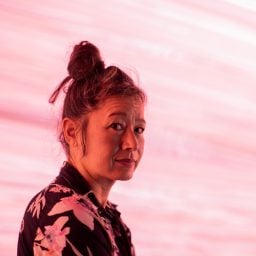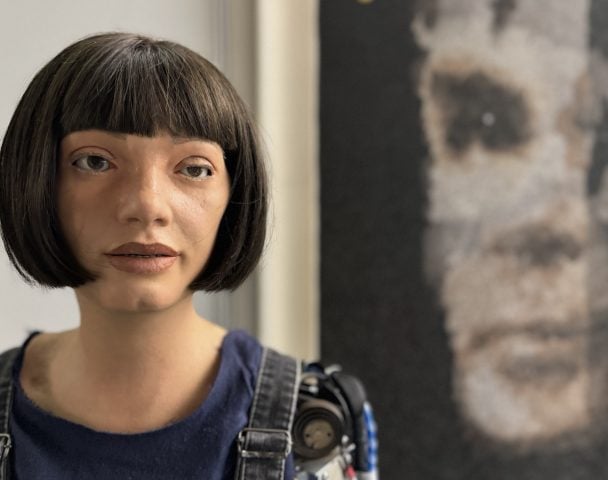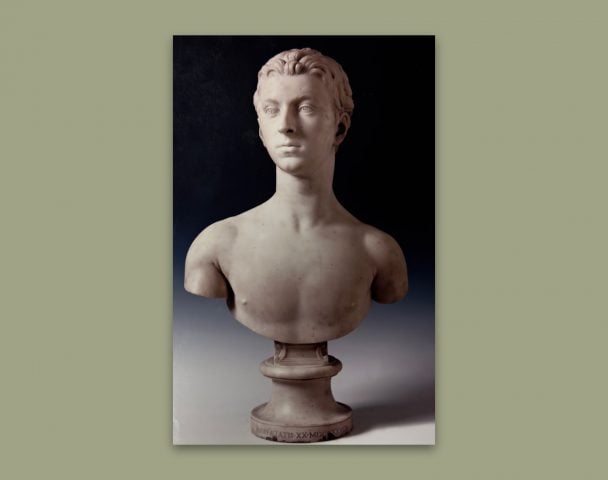Walking around the many spaces of Documenta 15 during its preview, I fell into and out of love with this massive show over and over again. I’m not talking about the major controversy that is currently rocking this always closely watched exhibition, which has shaken many people’s opinions of the whole thing—I’m going to get to that.
But first I want to talk about what it felt like in its opening days. If the whole thing closes over the current debates over antisemitism, we should at least have an idea of what other kinds of conversations have been cancelled out.
The exhibition is, first of all, massive—so massive that I definitely can’t say I’ve actually experienced close to all of it. Its curators, the Jakarta-based collective ruangrupa, invited a passel of other collectives, who then invited still more collectives and artists, who in some cases invited still more collectives and more artists. The result is a brain-busting program featuring thousands of names, spread out and packed into venues across the city, all doing different things.
The title this year is “lumbung,” a name for a collective rice barn, thus making sharing its hallmark theme. For an art viewer passing through, the effect of all this focus on collectives is, paradoxically, to render one’s experience very individual. You are just not going to have a shared experience of Documenta 15, which is too big to experience overall, designed to unfold over time, and different at every point you touch it.
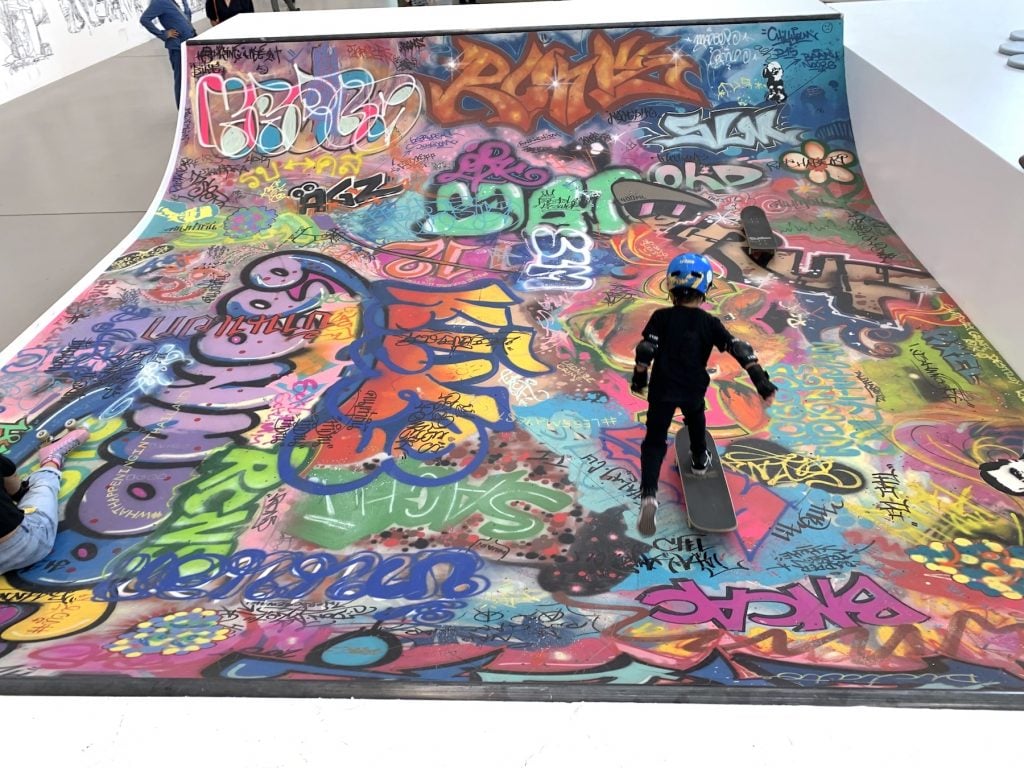
Skateboarders on Baan Noorg Collaborative Arts and Culture, Churning Milk Mini Ramp (2022) at the Documenta Halle. Photo by Ben Davis.
The show is by design anti-spectacular and light on big central images. At Documenta Halle, the photographers tend to gravitate towards a fittingly ordinary display of hanging-out: a rotation of live skateboarders who lackadaisically perform on a shallow, graffiti-splattered half-pipe. This is the work of Baan Noorg Collaborative Arts and Culture from Ratchaburi, Thailand (described as a “long term alternative interdisciplinary art and community-as-case study program based on post-studio and participatory practices”), teaming up with the local Mr. Wilson Skatehalle.
That staging of two cultures coming together around a common pastime mirrors another encounter set up by Baan Noorg as part of Documenta, maybe the real heart of their contribution: a commercial exchange between local dairy producers in Kassel and the town of Nongpho, advertised in a video above the half pipe.
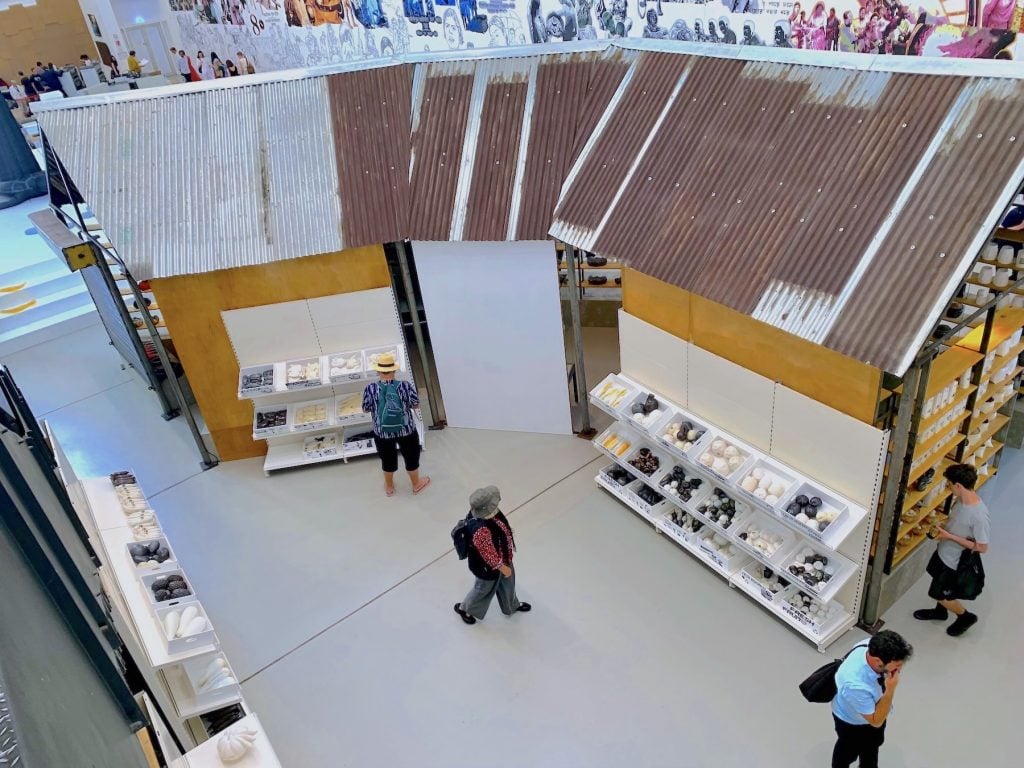
Installation by Britto Arts Trust at the Documenta Halle. Photo by Ben Davis.
Nearby, a mural fills the space with images appropriated from Bengali films by Dhaka-based nonprofit the Britto Arts Trust. In addition, group members have created a bazaar-like display, in the form of a series of stalls stocked with ingenious ceramic and crocheted replicas of everyday food items.
A short walk away at the natural history museum, a show about rural life by a Spanish collective, INLAND, gives way to a grotto full of AI-generated cave art and a characteristically digressive and trippy video by Hito Steyerl that tells the story of a modern-day shepherd who is part of the INLAND collective. (Steyerl and INLAND also collaborate on a crypto-currency parody called “cheesecoin” that proposes creating an “internet of stink.” More importantly, you can also sample INLAND cheese on site.)
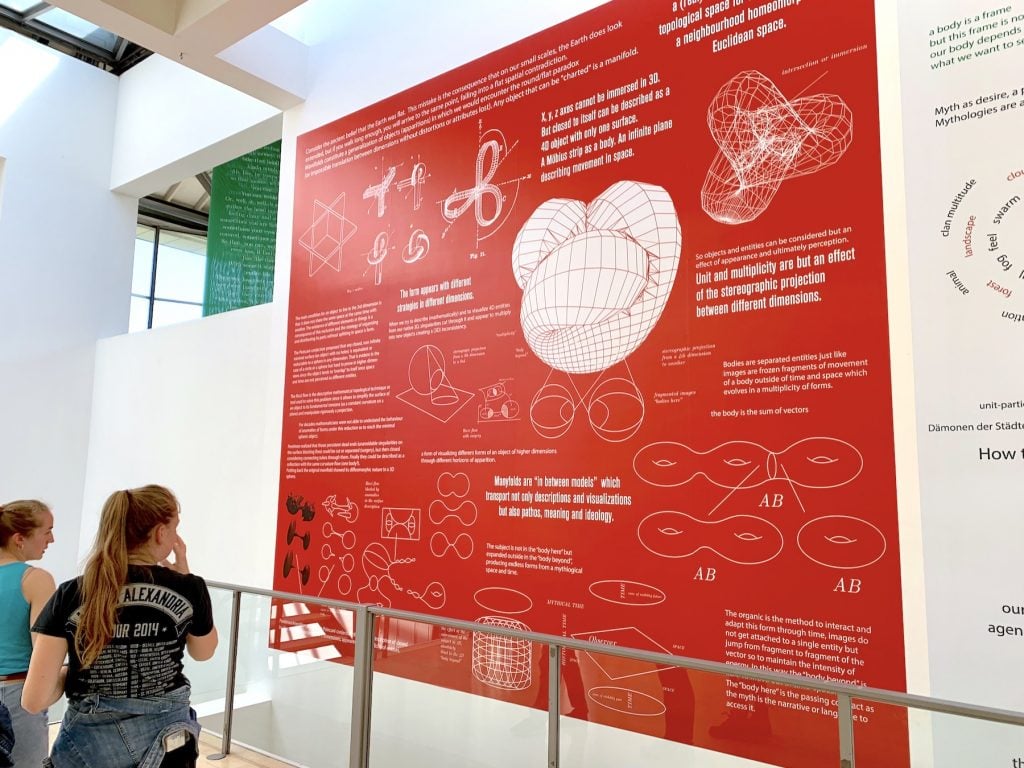
Works by Erick Beltrán at the Museum für Sepulkralkultur. Photo by Ben Davis.
At the Museum of Sepulchral Culture, Spanish artist Erick Beltrán’s complex, didactic installation Manifold (2022) is drawn from workshops he did with Kassel residents on what “power” might look like. It’s heady—though I admit I find the diagrams and word clouds illustrating the relationship between the positive value of “multiplicity” and the baleful, modern and Western concept of “unity” not really clarifying.
At the Stadtsmuseum, Sydney-based Safdar Ahmed presents Border Farce (2022). The two-channel video cuts between the testimony of Kazem Kazemi, an Iranian refugee who was detained in scandalous conditions on Australia’s Manus Island, with intense, psychedelic, and cathartic visuals by Hazeen, an “anti-racist Muslim death metal band” the artist formed, which also features Kazemi.
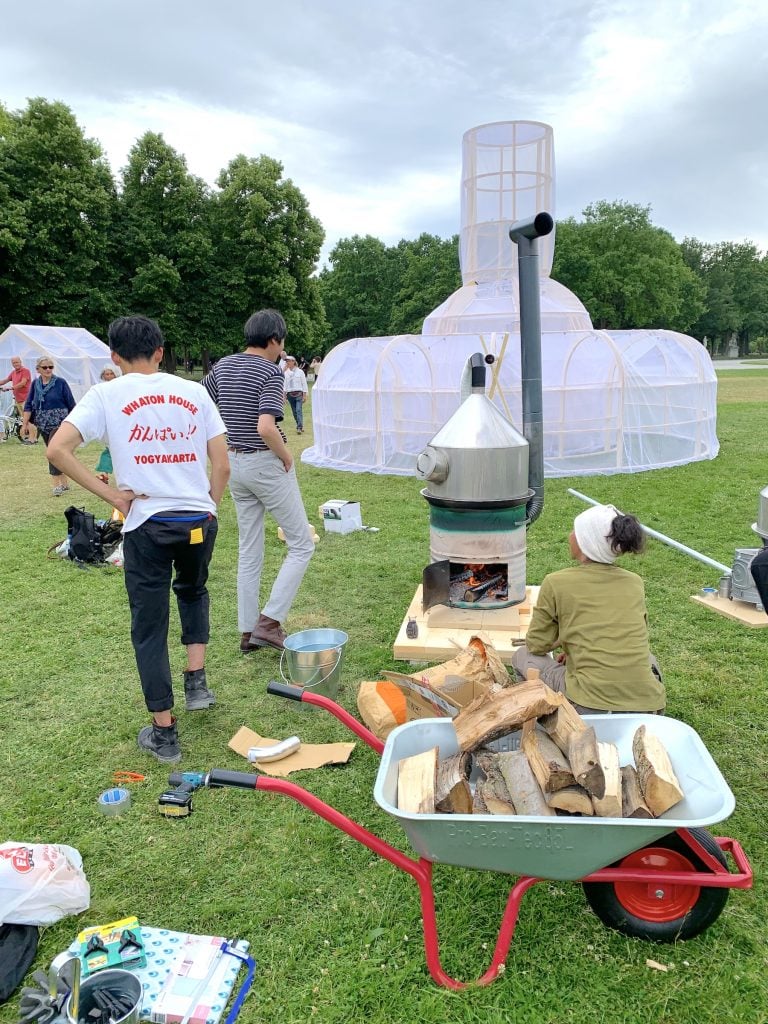
Cinema Caravan and Takashi Kuribayashi, YATAI TRIP PROJECT – road to documenta (2021-2022) in Karlswiese (Karlsaue). Photo by Ben Davis.
Out in Karlsaue park, in the large green swath in front of the Orangerie, there’s a tent by Chinese artists Cao Minghao and Chen Jianjun propagandizing the sustainable virtues of yak hair; a large structure, Return to Sender (2022), made of bales of textile waste that tries to confront the German audience with the extent of First World over-consumption by Nest Collective from Nairobi, Kenya; and a functional, make-shift sauna in the form of the Fukushima nuclear reactor brought to you by Japan’s Cinema Caravan, “a group of primates in the Good Vibes Hominidae family.”
Community Art and Community as Art
The projects of Documenta 15 often open onto past works of community-building or research, present pedagogical initiatives, or future processes unfolding during the 100 days of the show or beyond. A lot of it felt to me not like an art biennial, but like an art education biennial—with the strengths and weaknesses this implies. (Indeed, one prominent participant is CAMP notes on education, a collective that sprung from Documenta’s education and outreach department.)
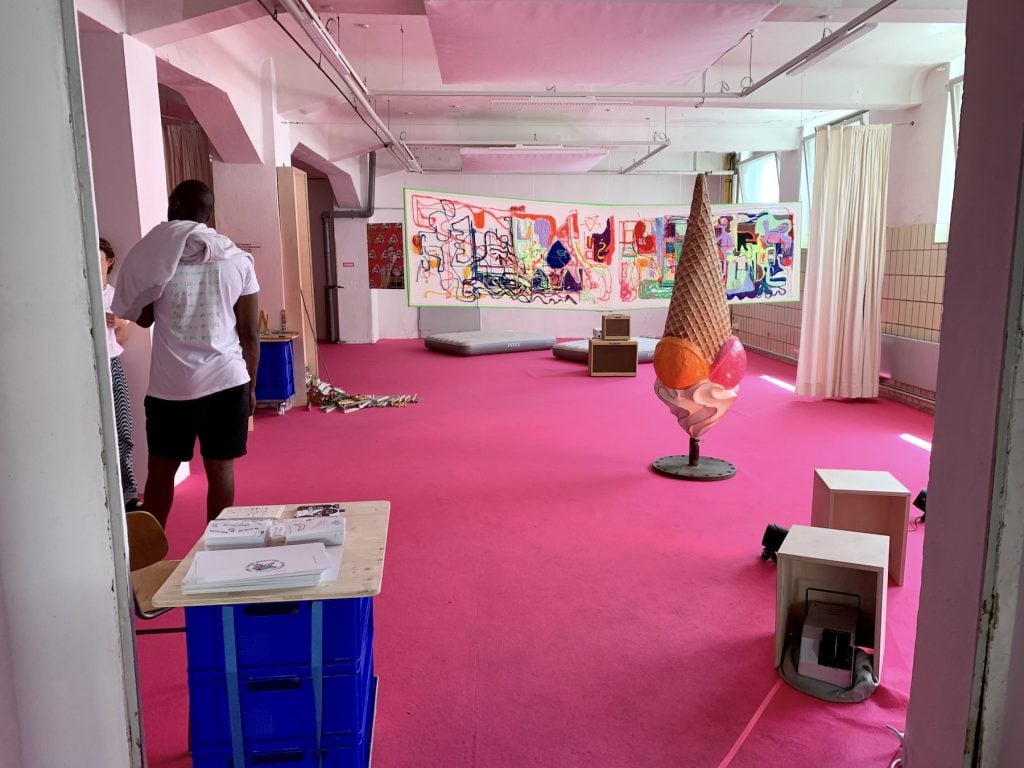
Camp Notes on Education, CAMP Space (2022) at Hafenstraße 76. Photo by Ben Davis.
Documenta 15 is full of activity tables, banners exhorting self-reflection and inclusivity, designated chill-out zones for the neurodivergent, childcare spaces for parents, community kiosks selling crafts and vinyl records, collaborative printmaking studios, participatory oral history projects, homages to composting and beekeeping (or, more specifically, a daft combination of beekeeping and cryptocurrency mining).
Objects are generally makeshift, unexalted, approachable. In film, the vibe is educational, with voiceover or talking heads soberly explaining historical events or topical concerns.
Ruangrupa emerged in the 2000s out of Indonesia’s grassroots, artist-driven, post-dictatorship art scene. Documenta 15’s framework suggests the massive exhibition as an attempt to showcase egalitarian survival strategies and community initiatives from the Global South (only a single group amid the sprawling program, Black Quantum Futurism, hails from the United States). The concept of “lumbung” is offered as a resource to “heal today’s injuries, especially ones rooted in colonialism, capitalism, and patriarchal structures.”
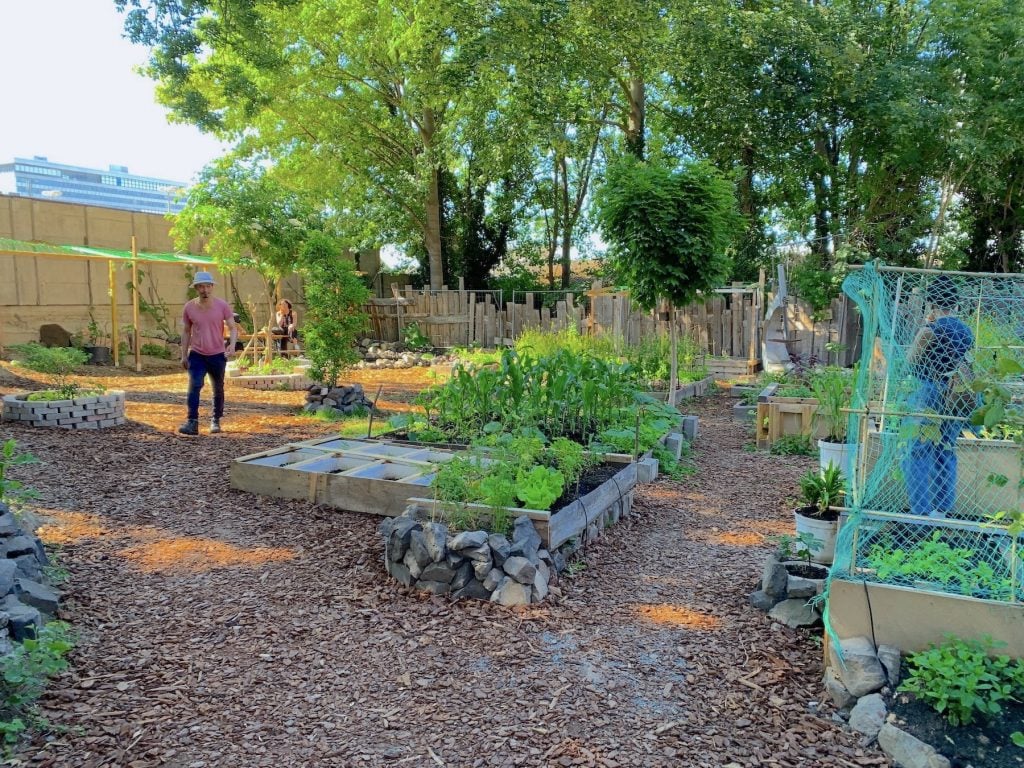
Community garden by Nhà Sàn Collective at WH22. Photo by Ben Davis.
And yet… review the types of initiatives most celebrated here: children’s theater, puppets, workshops on tolerance and stereotypes, street festivals, tributes to scrappy local enterprise, and, above all, community gardening and archives preserving various kinds of marginalized or endangered cultures (the last being the two major pillars of Documenta 15’s aesthetic program).
None of these are particularly beyond the pale for the typical German or U.S. are viewer. They are just more or less the accepted aesthetic preferences of international NGO culture, which values tangible deliverables and loves to produce texts with the word “community” in them. Indeed, almost all these works come with a label that explains what government agency or foundation has helped support them.
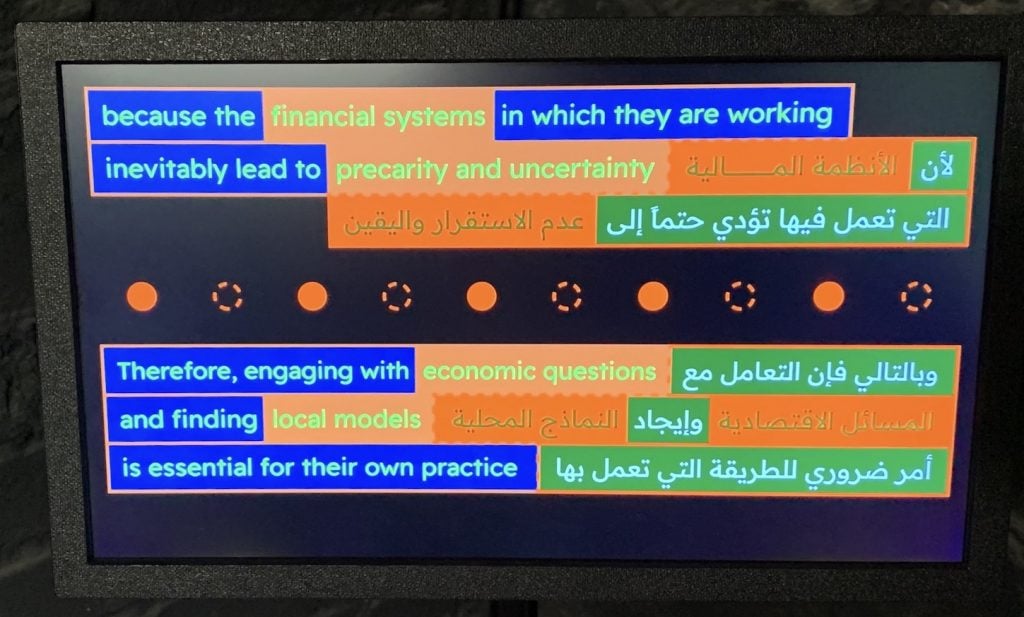
Video display for the Question of Funding laying out a pitch for Dayra.net. Photo by Ben Davis.
The Palestinian collective the Question of Funding actually has a video and associated brochure that directly critiques the ways that art philanthropy tends to produce cultures of dependency and limit political horizons. Unexpectedly to me, it turned not into a political call to change neocolonial funding structures but a call for Palestinians to use a blockchain-based service, Dayra.net, that allows participants to swap in-kind services. (Between this and Center for Art and Urbanistics’s “Beecoin,” Documenta 15 marks the arrival of blockchain at the highest level of the non-commercial side of the international art world.)
Much of the justificatory text here about sharing and cooperation as a new model of co-habitation that challenges neoliberalism and colonialism seems to me to mistake effects for causes. Things aren’t unsustainable, either in art or more broadly, because of a bad mindset. If all the artists in Kassel learn to better share the collective pool—and I’m not dismissing this, it’s a good thing—you are still left with the main problem: that a tiny group of the world’s population controls a vast majority of its wealth and resources, and has it in its interests to keep it that way.
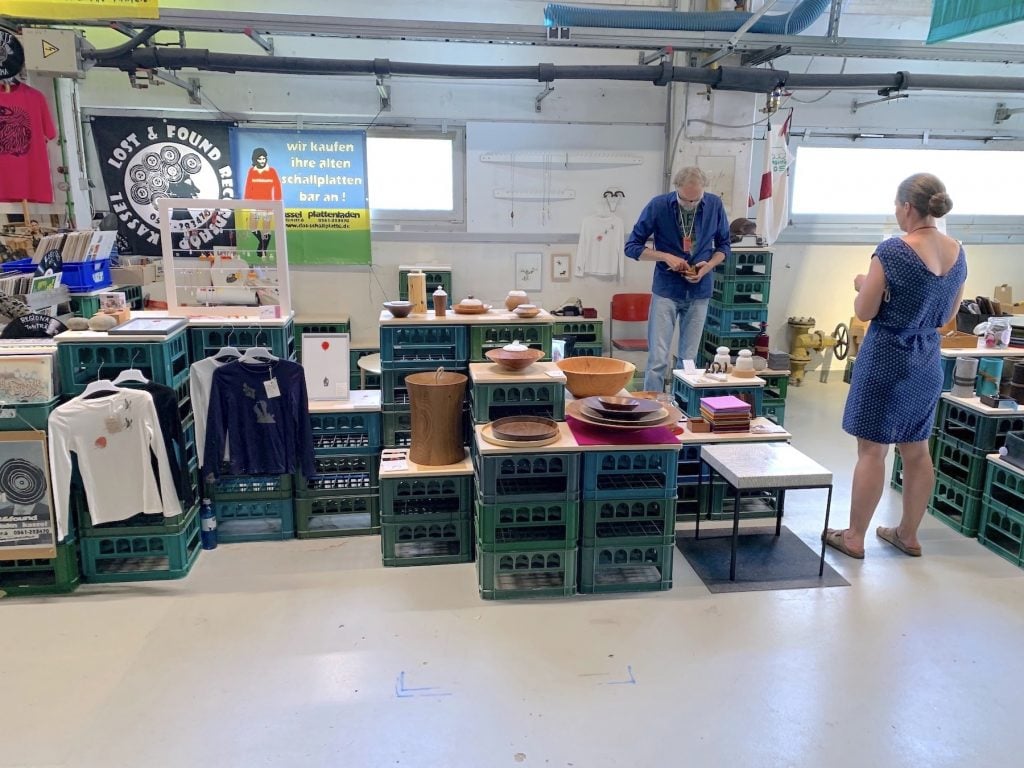
Lumbung Kiosk, a functional community shop, at work in Hübner-areal. Photo by Ben Davis.
The major problem is not an abstract “Western” habit of thought, like “hierarchy” or “individualism,” which you can fix by turning to collaboration. These are deflections of the kind that the non-profit world inculcates, as Anand Giridharadas argues in Winners Take All, because non-profit culture functions by reframing the “political as personal,” turning systemic problems into things that can be solved via workshops, at the level of interpersonal dynamics or clever bootstrap initiatives.
As ruangrupa would also admit, I think, the ascription of an inherently collective form of wisdom to the “non-Western” subject has its own history of “othering” undertones, acknowledged fitfully throughout the show. For instance, one of the many banners stating pedagogical principles hung by *foundationClass collective at the Hafenstraße 76 space features an (ironically anonymous) statement demanding an end to “the narrative of every German cultural institutions [sic] that only acknowledge us collectively and never as individuals worthy of self expression.”
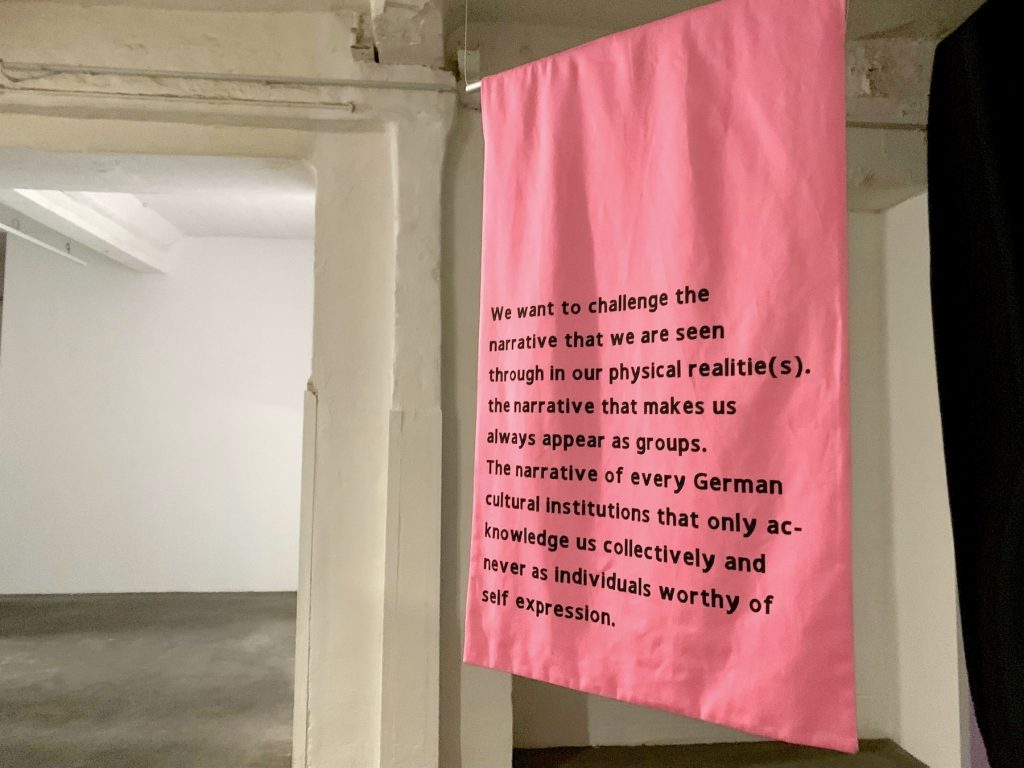
Banner by *foundationClass collective. Photo by Ben Davis.
Worth Celebrating
If I found myself enjoying the “lumbung” vibe despite reservations, it’s because, leaving aside the bigger questions about how viable or radical its proposals for new models for art are, ruangrupa’s focus on sociality just made for a show that feels very approachable and alive. And the particular network-of-networks that ruangrupa has pulled in genuinely feels like it knits together artistic scenes that are vital and under-known. They do have the popular touch.
The cadre of artists associated with Haiti’s Atis Rezistans (Resistance Artists), at the church of St. Kunigundis, beautifully commanded that space (I gather from a Times article that getting them permission to work in Germany required special attention). André Eugène’s elemental and unsettling sculptures incorporating human skulls dotted the floor, Edouard Duval-Carrié’s portraits of historic leaders of Haiti cut from blue mirrors commanded the walls, and Lafleur and Bogaert’s kinetic sculptures felt both like celebrations of everyday creativity and otherworldly.
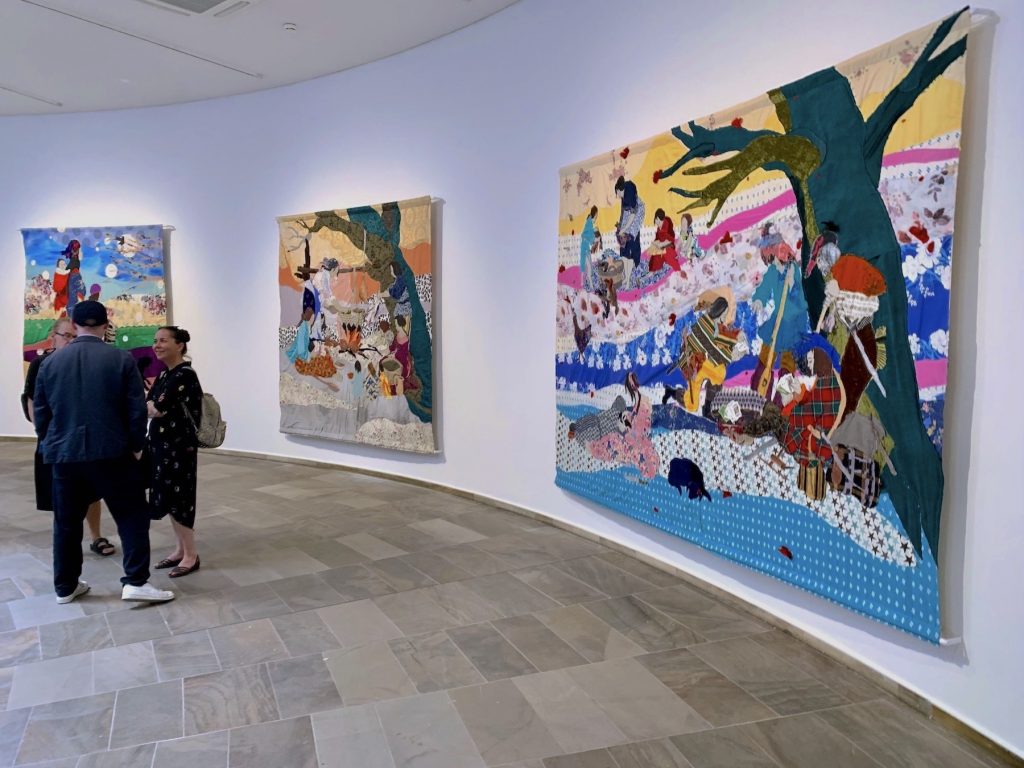
Works from Malgorzata Mirga-Tas’s “Out of Egypt” series on view at the Fridericianum. Photo by Ben Davis.
At the Frederiecanium, inter-leafed throughout the various floors was a display showcasing recent work by artists from Roma backgrounds. It included Birth, a wild, historically important, multi-panel painting of a Roma origin myth by Tamás Péli from 1983; Damian le Bas’s 2013 painting Safe European Home, a map of Europe rendered as a strange, interlocking mosaic of faces; and Malgorzata Mirga-Tas’s recent “Out of Egypt” series (2021) of embroidered panels appropriating cliched images from 17th century etchings depicting the Roma people as lost Egyptian tribes, using textiles upcycled from clothing worn by the artist’s present-day Roma community.
Also in the Frederiecanium, one screening room focuses on the legacy of Sada, a collective set up in 2011 to support artists and students in post-occupation Iraq, so completely memory-holed in the U.S. after official military withdrawal. The group’s founder Rijin Sahakian has a film essay that lucidly lays out how recent U.S. culture was shaped by the recent geopolitical crime. Her work has a sense for the darkly resonant image that makes the charges stick, but it’s also memorably direct, without poeticizing its subject.
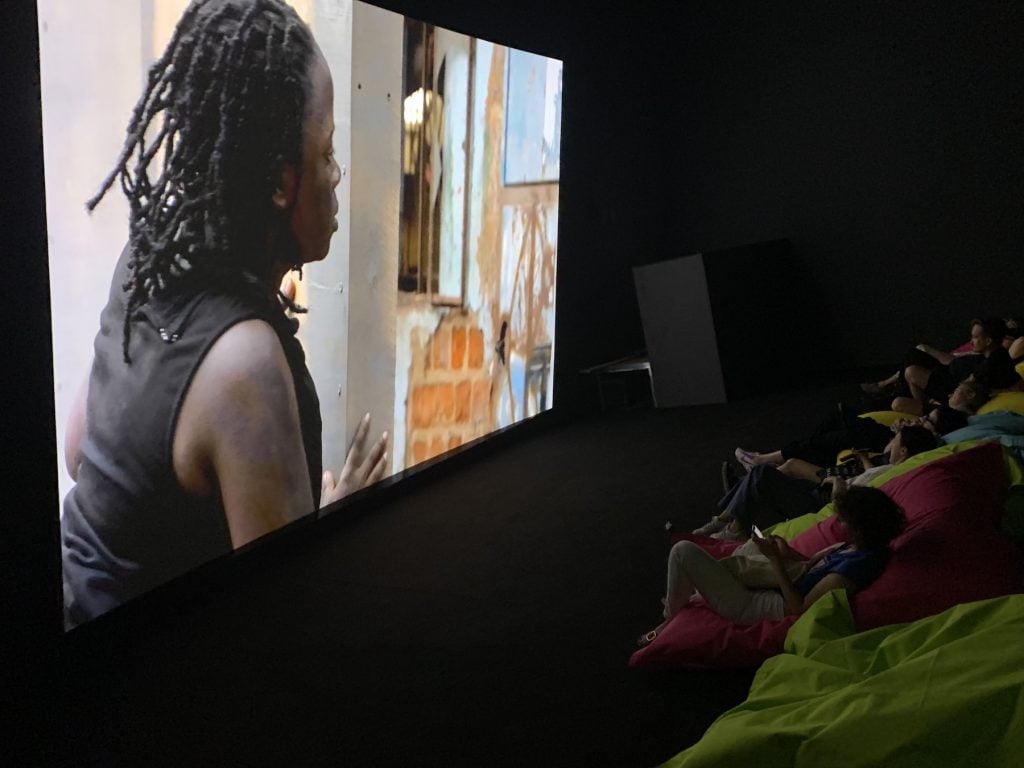
Visitors watching Wakaliga Uganda’s Football Kommando at the Documenta Halle. Photo by Ben Davis.
On a totally different wavelength, I liked Football Kommando, from Wakaliga Uganda, a beyond-low-budget studio based outside of Kampala founded by Isaac Godfrey Geoffrey Nabwana, a.k.a. Nabwana IGG. At one end of Documenta Halle, you enter the screening room past walls studded by homemade posters for the studio’s various adventure movies. A spy caper, Football Kommando tells the tale of a German footballer teaming up with an ass-kicking Ugandan mother, bringing his prowess with a soccer ball to a mission to rescue her kidnapped daughter. It’s fun. It’s also unlike anything I have seen at a biennial before.
The Only Conversation That Matters
I mention the questions the show raises about its artistic framework as well as the real highlights because I think both deserve space that the current meltdown is destined to make impossible. I said I hadn’t seen the whole show. Clearly, the curators hadn’t either.
A slow-moving storm of criticism had haunted the show in the weeks leading up to it, touched off by a local blog decrying the “left-identitarian and postmodern art world,” and presenting any criticism of Israel—or public sympathy for Palestinians—as de facto antisemitic. As the charges of antisemitism circulated more generally in the German press, the bulk of the case was that the show featured many Palestinian artists talking about their plights, but no Israeli-Jewish artists; and that some artists in the show had signed various petitions in support of boycotting Israel or against Germany’s 2019 parliamentary motion conflating boycotts of Israel with antisemitism. (In the United States, a measure outlawing boycotts of Israel is probably heading to the Supreme Court.)
But shortly after the opening of Documenta 15, observers discovered antisemitic caricatures within a large banner shown in the main plaza in front of the main Frederiecanium site by the Indonesian art collective Taring Padi. The 2002 work, People’s Justice, was a four-story-tall, scabrous tableau. It depicts the struggle between the heroic Indonesian people, shown on the right side as a flow of figures surging into battle beneath a banner that says “Resistance Culture Movement,” against the dictatorship of the then-recently deposed Suharto regime and the international forces that had supported it, illustrated on the left.
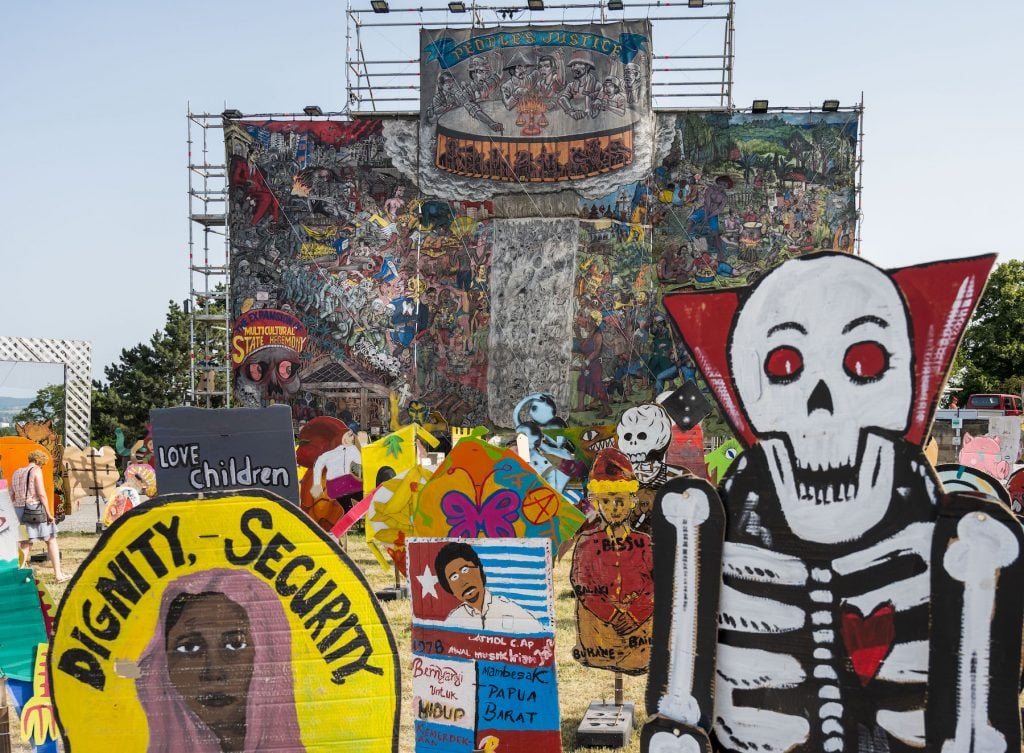
People’s Justice by the Indonesian artists group Taring Padi hangs behind cardboard figures at the Documenta 15 on June 18, 2022 in Kassel, Germany. (Photo by Thomas Lohnes/Getty Images)
Suharto is depicted in a red suit with lizard eyes at the top left, seated on a throne beneath a tower bearing the flags of the United States and Great Britain, with war planes soaring past them into the skies. At bottom left, an immense skull with bloodshot eyes is accompanied by a banner that reads “The Expansion of ‘Multicultural’ State Hegemony.”
Amid this fetid landscape of evil cartoons, it’s hard to take in every detail. You see a grinning king fornicating with a crying woman who is also a windup doll. You see a grotesque fat figure with a beast’s snout, wearing a songkok, stuffing his face with a giant sandwich, pants busting open. You see a see a garishly made-up beauty queen, nipples projecting through her top, whose sash reads “Plastiks.” You see a drooling man hypnotized by a TV labeled “PROPAGANDA BOX.”
Near the front, there is a commando with a pig face, sporting a red beret and a U.S. flag patch, masturbating onto a grave covered in skulls with one hand and giving the thumbs up with the other. Running to join him is a line of helmeted, beast-faced storm troopers, led by a duo labeled “007” and “KGB.” About midway back in this line of troopers, just in front of a figure labeled “ASIO” (the Australian intelligence service), is a figure labeled “MOSSAD” and bearing the Star of David, also with a pig face.
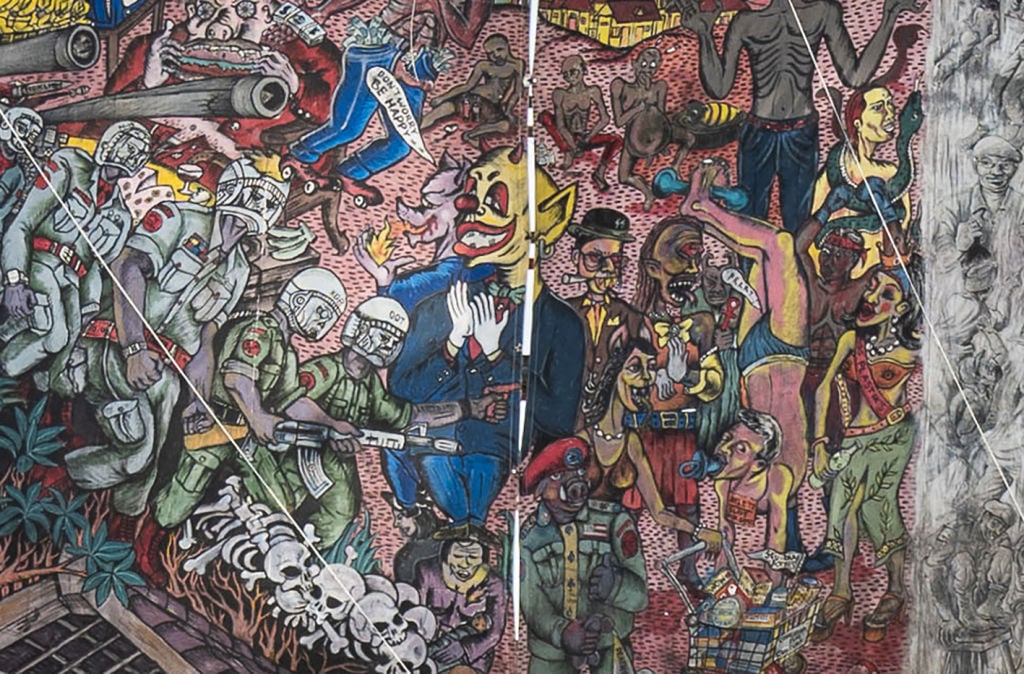
Detail of the mural People’s Justice by the Indonesian artist group Taring Padi. (Photo by Thomas Lohnes/Getty Images)
Nearby is a an evil wolf with a blood-soaked mouth with a talking balloon saying “Don’t Worry, Be Happy,” a towering devil-clown applauding the storm troopers—and beside these, a tiny image of a cigar-chomping, fanged man with sidelocks, clearly a caricature of an Orthodox Jew, with a Nazi “SS” on his hat.
Whatever its background in expressing visceral rage at international forces tied to Suharto’s historic crimes—and Israel really did deal weapons to Suharto—People’s Justice clearly evokes antisemitic imagery.
When the scandal broke, the work was first covered and then taken down; the artists and curators apologized; and matters have escalated from there, with plans for a systematic review of the show for antisemitism and calls for the head of both Documenta and the German culture minister to step down, and for the show to be shuttered altogether.
Taring Padi is a storied activist collective with undefined membership that is known to “reject the notion of art for art’s sake,” as the Jakarta Post put it, very much in the politicized and grassroots vibe that is closest to ruangrupa’s heart. They are very prominent in Documenta 15—maybe the most prominent presence.
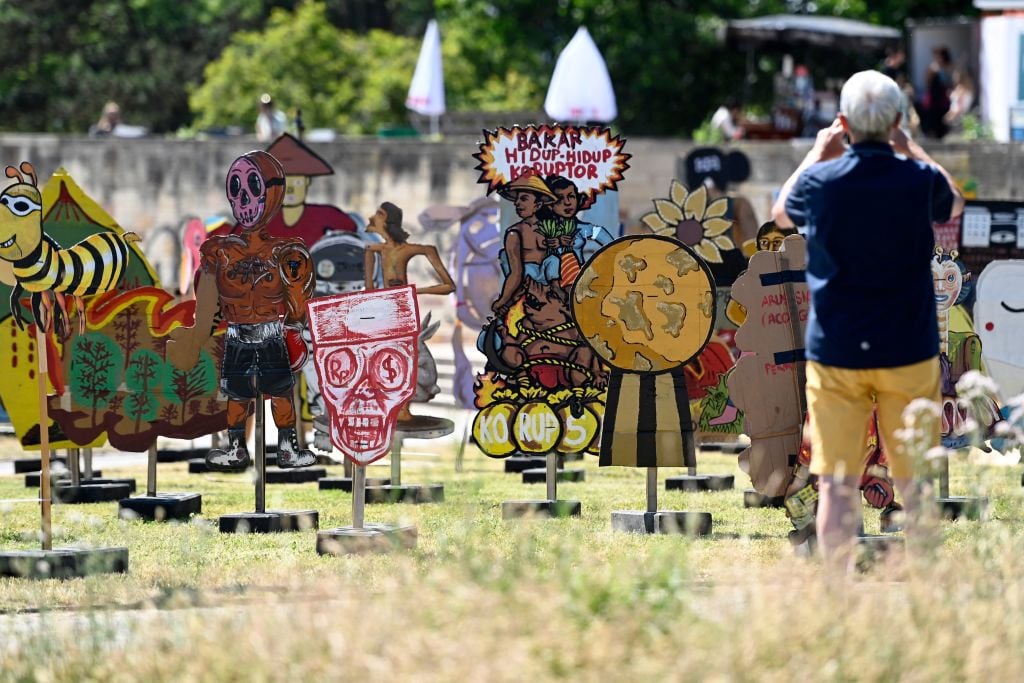
Cardboards, a work of the Indonesian art collective Taring Padi, at the Friedrichsplatz square in front of the Fridericianum Museum, one of the venues of Documenta 15 in Kassel. Photo: Ina Fassbender/AFP via Getty Images.
Their cardboard signs featuring cartoons and social justice slogans about various causes, staked into the ground, filled the main site of the show, while an entire venue, Hallenbad Ost, was dedicated to a retrospective of their political graphics and banners.
That show is called “Flame of Solidarity: First They Came for Them, Then They Came for Us.” That’s a reference to Martin Niemöller’s famous 1946 poem about the rise of Nazism. “Then they came for the Jews, and I did not speak out—because I was not a Jew…”
As Jörg Heiser noted at Art Agenda, a critical essay archived on Taring Padi’s own website pointed out that how the satire of their political graphics “tend to reproduce the common, normative, and stereotypical messages” of Indonesian society, in particular when “depicting the physical and stereotypical attributes of religious, racial, and ethnic diversity.” The danger of something dire like this happening is actually the flip side of the curatorial emphasis on demotic, “popular” culture: The more that aperture opens, the more chance you have to reckon with tropes and stereotypes that a more carefully sterilized academic culture brackets out, because “popular consciousness” is not unilaterally righteous or pure.
I sort of agree, then, with an essay by curator Mohammad Salemy (though not with his title, “Antisemitism Is the Least of Documenta’s Problems”), when he says that in some sense this scandal grows out of the entire delegated curatorial framework of Documenta 15. Assuming for a minute that neither Taring Padi nor ruangrupa were attempting to dog-whistle to neo-Nazis with People’s Justice, the work simply would not have been shown in a more carefully curated show.
But the work was shown. The fallout will be immense.
“Documenta 15: Lumbung” is on view in Kassel, Germany, through September 25, 2022.
